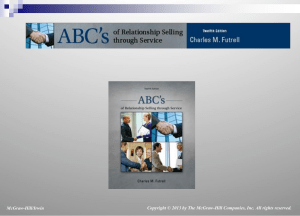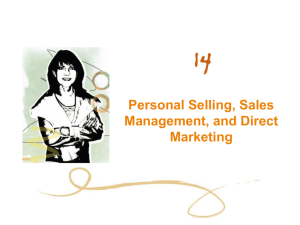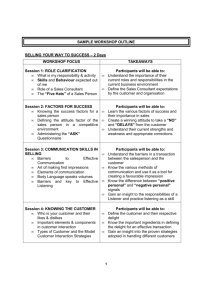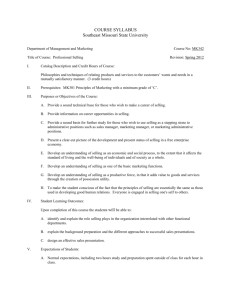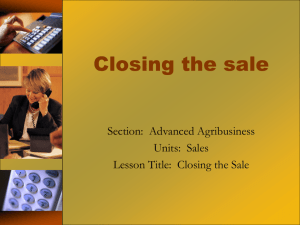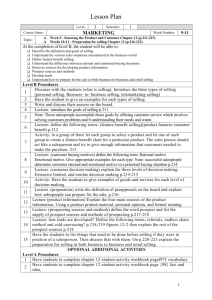The Close
advertisement
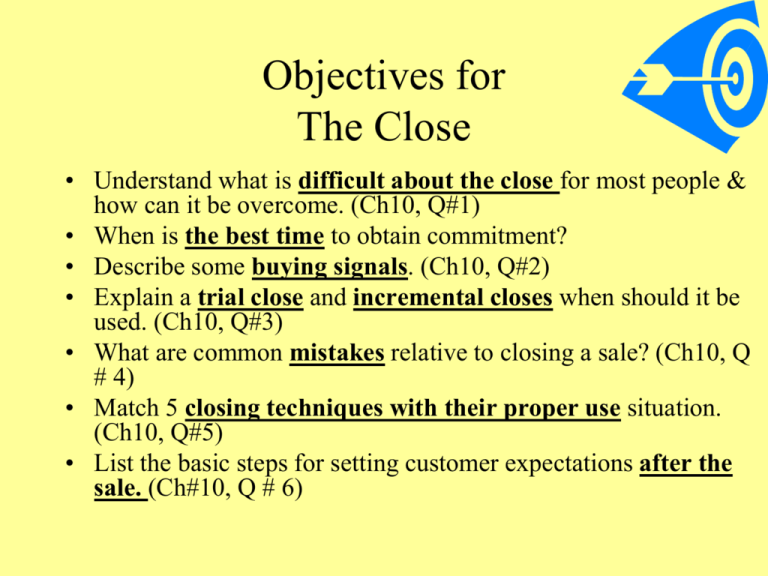
Objectives for The Close • Understand what is difficult about the close for most people & how can it be overcome. (Ch10, Q#1) • When is the best time to obtain commitment? • Describe some buying signals. (Ch10, Q#2) • Explain a trial close and incremental closes when should it be used. (Ch10, Q#3) • What are common mistakes relative to closing a sale? (Ch10, Q # 4) • Match 5 closing techniques with their proper use situation. (Ch10, Q#5) • List the basic steps for setting customer expectations after the sale. (Ch#10, Q # 6) What is the “Close?” Close – (v) to unite; to reach an agreement. Closing in the sales process can have two meanings: • ______________________________________ • ______________________________________ • Asking for the order transforms prospects into customers • Agreeing to the next step keeps the problem solving process going Chapter 8 2 McGraw-Hill/Irwin Obtaining Commitment Today Selling Chapter #12 • Buyers want to buy, • Reliance on closing techniques may . • No commitment, no sale. • ________________________________. 12-3 The CLOSE • The Close is: – Realizing your sales call ________________ – Obtaining a commitment from the prospect – Often involves getting the order or an agreement to a trial or plan. • The close transforms ___________ into _________ • The close is the gauge for success of your sales call. – Did you accomplish or exceed what you set out to accomplish? – Builds on good.. Preparation, Opening, Presentation & handling objections. – The close motivates the prospect to __________________ The CLOSE (Ch10, Q#1) • Closing is challenging for many salespeople because – Asking for the order is the __________________ – -indicates success or failure – __________________________________________ – It’s difficult to ask people to _________their _________ resources – The salesperson may not be _____________________________________________ Asking for the Order • “Asking for money” may seem _________________ • The only way for your customer to gain the __________________________________________ • When they do not get the benefits that you believe strongly are possible … _______________________ 6 Chapter 8 6 Asking for the Order • Consider that . . . • The customer has spent time with you • The customer agreed to work with you to find a “best” solution • They have given you information or talked with you about their satisfaction with past solutions • So, they ___________________________________ 7 Chapter 8 7 Closing • Be assertive • The difference between “pushy” and “assertive” is ___________ • It is far more common for salespeople to err on the side of __________________________ Chapter 8 8 The CLOSE-Closing Suggestions • 1) Be _____________and ______________ – Remember asking for the order _____________________________________________ – Be positive but avoid being _____________ – Be ready to probe for _________________________ What is a close? It is not a ________________ situation where, control can often be important. In a sales situation the buyer and seller are attempting to become … _____________________________________ ______________________________ When to Close • Close whenever the prospect is ready to buy! • It is easy to “oversell” • Many salespeople, feel compelled to ________________________________________ • They may actually __________________________ • When the prospect has sufficient information to make an informed decisions …CLOSE! Chapter 8 11 DISC Communication Styles • Part of knowing when to close will depend on the buyer’s communication style • High D’s may want to move to a decision __________________________________________ • High I’s may appreciate your __________________________________________ • High S’s may like something _______________ • High C’s may want you to __________________________________________ Chapter 8 12 McGraw-Hill/Irwin 2.) When to Attempt to Obtain Commitment • Buyer comments – – – – ___________________ ____________ ___________________ ____________________ ____________________ • Nonverbal cues – ____________________ – ____________________ 12-13 Requirements are conditions that have to be met before a _____________ _____________ 2) Know WHEN to CLOSE (Ch10, Q# 2) Buying signals: ___________________________________________ that indicate a buyer’s willingness to commit to your product/program ________________: Questions on buying; Enthusiastic acceptance; Conditional willingness to purchase ____ : Frequent nodding; Steps back and admires product Verbal Buying Signals • By tuning in to the customer, the salesperson can identify when it is time to close • One clue is when the customer is doing almost as much of the talking as the salesperson • Another clue is when the customer begins talking about steps that would _________________________________ • Delivery, Training, or Financing, for example. Chapter 8 15 “Mini Closes” Throughout The Call (Ch10, Q#3) • Actually, a good salesperson closes _____________________ throughout the call . . .getting agreement on each step or selling point that leads to final agreement to buy. • This is called an ___________________. – “Based on what you have told me so far . . . I think I have an idea that could really help. May I share what I have in mind?” – “How important is this auto engine-kill switch to your operators, Arnie?” – “So, the maintenance contract has some real merit for you, right? The Trial Close • The trial close is a question usually asked____________ through the presentation that is designed to find out where the prospect is in their buying decision • The trial close usually is a subtle to buy – Examples . . . – _______________________________________________ – _______________________________________________ – _______________________________________________ – _______________________________________________ – _______________________________________________ Trial Closes If your customer already knows you and the product you can sometimes begin the call with a trial close. __________________________________ __________________________________ ________________________________ APPEAL TO THE SENSES ______________________________________ _______________________________________ ___________________________________ __________________________________ How Not to Close A Sale • Closing is a time to show confidence in your solution • Never - Never - Never start a close by stating their _______________ _ “___________________________________________ – ____________________________________________ – _____________________________________________ _____________________________________________ Techniques to Close the Sale (Ch#15 Q# 5) • There is no “ commitment ” to get – But there are five commonly used techniques . . . 1. The ______________close 2. The ______________close 3. The ______________close 4. The ______________close 5. The ______________ close • Continuous yes close fits under 2 & 4 above The Direct Close • Simply ______ the customer for their business. – “Gloria, we’d like to do business with you. How about giving us a chance to show what we can do?” • Works well when . . . – The sales relationship is and __________ – The salesperson has just handled ___________________________________ – The salesperson and customer have a – __________________________________ The Summary Close • Briefly summarize the ___________________________________ – including benefits to the customer and address any major concerns as benefits to the client • Usually involves the following steps: – __________________________________________ – __________________________________________ – __________________________________________ – __________________________________________ The Choice Close • Offer the customer a -but not the choice between • “Would the standard or the deluxe model work best?” • “Would you prefer cash or to be billed later?” • “Which day of the week do you prefer delivery?” (also called the fatal alternative) • The choices offered are drawn from information you The Choice Close Give the customer the Notice that there is NOT Melissa- Kraft Foods Would you like the Green or Blue model?? The Assume Close • Do not ask for the order but assume they are ready to buy and • On the surface this sounds presumptive and even arrogant but when in the context of a strong relationship ____ • It works best with ____ or when the prospect has ____ The Assume Close • Four types of assume closes: – assumption “Great! I stop by tomorrow and begin pulling soil samples!” – assumption “What I think you need is about three boxes to get you started. I’ll get is shipped out yet today.” Command Assumption Things to notice • _____________________ • _____________________ • Opportunity for a _______________________ _____________________ • _____________________ • Just do it! The Assume Close _____________ - assumption • _________________________________________ – “You are really going to enjoy the convenience of those doors.” – _____________ - assumption ________________________________________ ________________ - assumption • ________________________________________ – or finalize paperwork for their signature Special Feature Close or Benefit in Reverse Close After other attempts to close add something to the value bundle • ___________________________ • ___________________________ Something to push them over the edge on their decision to buy • Be sure they don’t feel ________________ • They will come to ____________________ Continuous yes close ( as long as it isn’t manipulative) • Seller constantly asks questions for which the buyers answer is ________ • By the end of the presentation the natural answer is _________ • Follows naturally as a summary close or leads to the assume close Better thought of as a buying signal as you are doing trail closes The Close ____________________ __________________ Carla- Armour Swift Eckrich Tim - Hormel _________________________________ _______________________________ After They Say “Yes” • Immediately after a customer says “YES” there are several things that become important • ____________________ • ____________________ • Clarify next steps • Manage expectations ______________________ Chapter 8 32 McGraw-Hill/Irwin If Commitment is Obtained • No surprises- many salespeople make serious mistakes here ___________________________________ _______________________________. • Confirm the customer’s choice • Get the signature – Make the actual signing an ____________________ – Fill out the order blank accurately and promptly – Be careful not to exhibit ______________________________________ at signing time …. Why? 12-33 Reinforce the Customer’s Choice • Immediately after saying “yes,” many customers experience second thoughts • This is called _________________________ • Customer begin to ask themselves did I. . . Did I really need that product or service? Did I need to buy it now? Did I pay too much? Will this product really meet my needs? Reinforce the Customer’s Choice • It is also good to reinforce why they have made a good decision _______________________________ • Buyer’s ______________ usually happens after you have left them • Give the customer a call or stop with an appointment in a few days and ask if they have any additional questions and _____________________________________ What If they Say, “No.” added slide • No one likes to be turned down • It is difficult not to take rejection personally • Remember -- When the customer says, “No” • They are saying “No” to _____________________ • They are not saying _____________________ • They are just saying _____________________ Chapter 8 36 What If they Say, “No.” • Leave the door open for future business • Their circumstance ___________________ • They may change ____________________ In all cases, _____________________________________________ • If there could be a future opportunity, ____________________________ Chapter 8 37 McGraw-Hill/Irwin If Commitment is Not Obtained • Some reasons for lost opportunities – _____________________________ – _____________________________ – _____________________________ • Discovering the cause – Critical so that salespeople can proceed intelligently to _________________ 12-38 McGraw-Hill/Irwin If Commitment is Not Obtained (continued) – Suggestions for dealing with rejection • ________________________ ________________________ • ________________________ • ________________________ ________________________ 12-39 What would you say to a friend to gain his or her commitment to go on a spring break trip? Describe exactly what you would say to your friend, using each of the following methods (make any assumptions necessary): a. Alternative choice _______________________________________________________________________ b. Direct request. _______________________________________________________________________ c. Benefit summary. _______________________________________________________________________ _______________________________________________________________________ _______________________________________________________________________ d. Summary of pros and cons or balance sheet close _______________________________________________________________________ _______________________________________________________________________ _______________________________________________________________________ e. Summary by Probing. _______________________________________________________________________ _______________________________________________________________________ _______________________________________________________________________

